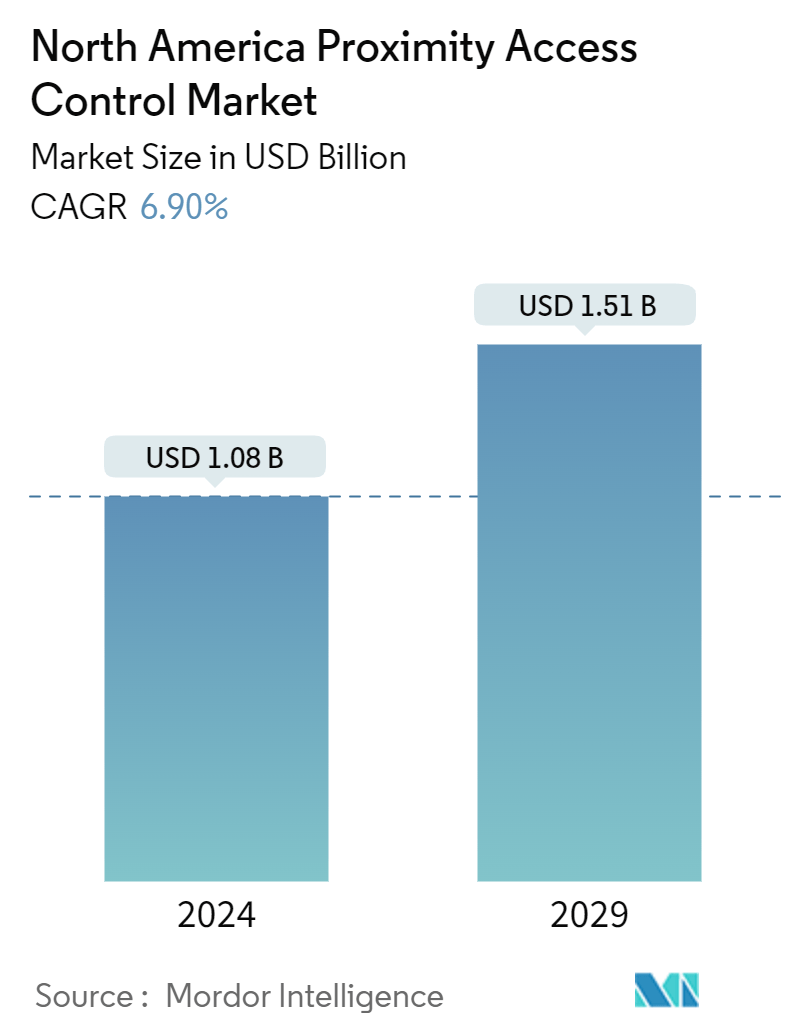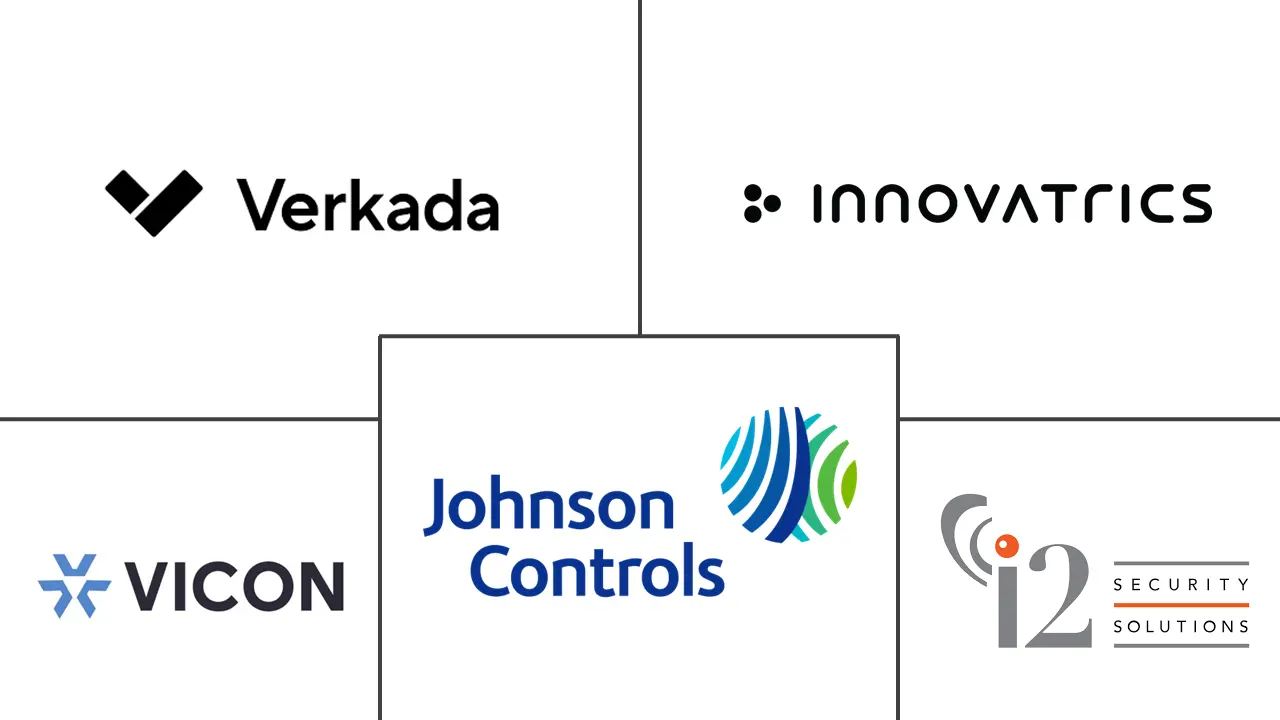Market Size of North America Proximity Access Control Industry

| Study Period | 2022 - 2029 |
| Base Year For Estimation | 2023 |
| Market Size (2024) | USD 1.08 Billion |
| Market Size (2029) | USD 1.51 Billion |
| CAGR (2024 - 2029) | 6.90 % |
| Market Concentration | Low |
Major Players
*Disclaimer: Major Players sorted in no particular order |
North America Proximity Access Control Market Analysis
The North America Proximity Access Control Market size is estimated at USD 1.08 billion in 2024, and is expected to reach USD 1.51 billion by 2029, growing at a CAGR of 6.90% during the forecast period (2024-2029).
- The utilization of access control systems for companies of all sizes has increased over recent years, driven by physical and cybersecurity threats. This increase is attributed to various factors, including increased criminal activity, technological progress in security systems and all aspects of business technology, and a rising trend toward cloud-based security solutions.
- Organizations have become increasingly focused on cybersecurity and digital intelligence, with particular emphasis on IT departments, and these elements are beginning to influence business buyers' decisions. As a result, digitized security systems are becoming the norm. Companies are beginning to recognize the numerous benefits digitized plans offer employees, ranging from increased productivity to the convenience of smartphone-based access. This shift toward more smart digital workplaces has just begun and is expected to continue for an extended period.
- For instance, in June 2023, Hanwha Vision America announced that the company had integrated the VMS (Wisenet WAVE) with Symmetry Technology's Access Control software. This integration was achieved by implementing the AMAG Integration Plugin, which facilitates the transfer of video cameras registered in the VMS to mapped sources within Symmetry software, such as access card readers, which can then be accessed in Symmetry's interface.
- Managed access control systems remain one of the primary components of physical security across most modern organizations, driving the market's growth. One of the primary advantages of hosting commercial security systems in a cloud-based environment is that businesses can have more control over the live installation of these systems.
- For instance, teams must access management platforms through the site's local network to effectively manage access controls and user authentication within a traditional, on-site system. This step indicates that the adjustment of functions such as active permissions, data security software, and access control door latches can only be done by teams from security and IT.
- Biometric scanners are integrated into Access Control systems to assess the appropriateness of an individual's access to a given facility or system. This biometric information is then cross-referenced with templates stored in a database to verify identity. For instance, as of August 2023, X's revised privacy policy will authorize the collection of biometric data from specific users. X will allow the user to present their government ID in conjunction with a selfie to add a layer of verification. Additionally, biometric data can be extracted from the ID and the selfie for matching purposes, which is intended to assist X in combating impersonation and enhancing the platform's security.
- Changing work patterns, such as the prevalence of remote work, may decrease the demand for physical access management systems in specific industries or enterprises. Major security incidents, such as breaches, can sometimes also result in heightened security awareness and investment in security systems.
- Regulatory and compliance developments in the region may also affect the need for access control solutions, either by necessitating a more robust system or by lowering the requirements. However, these events can also lead to temporary market instability, thus impeding the development of the market.
North America Proximity Access Control Industry Segmentation
The study tracks the revenue accrued through the sale of proximity access control hardware and software products by various players in North America. The study also tracks the key market parameters, underlying growth influencers, and major vendors operating in the industry, which supports the market estimations and growth rates over the forecast period. The study further analyses the overall impact of COVID-19 aftereffects and other macroeconomic factors on the market. The report's scope encompasses market sizing and forecasts for the various market segments.
The North American proximity access control market is segmented by solution (hardware and software), type (card readers, biometric scanners, proximity readers, alarms, metal detectors, door controllers, and wireless locks), end-user industry (government services, banking and financial services, it and telecommunications, transportation and logistics, retail, healthcare, residential, and other end-user industries), and country (United States and Canada). The market sizes and forecasts are provided in terms of value (USD) for all the above segments.
| By Solution | |
| Hardware | |
| Software |
| By Type | |
| Card Readers | |
| Biometric Scanners | |
| Proximity Readers | |
| Alarms | |
| Metal Detectors | |
| Door Controllers | |
| Wireless Locks |
| By End-user Industry | |
| Government Services | |
| Banking and Financial Services | |
| IT and Telecommunications | |
| Transportation and Logistics | |
| Retail | |
| Healthcare | |
| Residential | |
| Other End-user Industries |
| By Country | |
| United States | |
| Canada |
North America Proximity Access Control Market Size Summary
The North American proximity access control market is experiencing significant growth, driven by the increasing need for enhanced security measures across various sectors. This growth is fueled by the rising concerns over physical and cybersecurity threats, technological advancements in security systems, and the shift towards cloud-based security solutions. Organizations are increasingly prioritizing cybersecurity and digital intelligence, leading to a greater adoption of digitized security systems. This trend is further supported by the integration of advanced technologies such as biometric scanners and card-based systems, which offer improved security and convenience. The market is characterized by a competitive landscape with numerous players striving to expand their market presence through strategic partnerships, product innovations, and collaborations.
The market's expansion is also influenced by changing work patterns, regulatory developments, and the need for modernized access systems. Card-based systems, in particular, are gaining popularity due to their versatility and ease of integration with various systems. The demand for access control solutions is further bolstered by the increasing incidence of data breaches and the need for robust security measures in urban areas. As organizations and governments continue to invest in advanced access control technologies, the market is poised for continued growth. The introduction of innovative products, such as wireless locks and multimodal biometric devices, underscores the ongoing technological advancements shaping the industry.
North America Proximity Access Control Market Size - Table of Contents
-
1. MARKET INSIGHTS
-
1.1 Market Overview
-
1.2 Industry Attractiveness - Porter's Five Forces Analysis
-
1.2.1 Bargaining Power of Suppliers
-
1.2.2 Bargaining Power of Consumers
-
1.2.3 Threat of New Entrants
-
1.2.4 Threat of Substitutes
-
1.2.5 Intensity of Competitive Rivalry
-
-
1.3 Impact of COVID-19 Aftereffects and Other Macroeconomic Trends on the Market
-
-
2. MARKET SEGMENTATION
-
2.1 By Solution
-
2.1.1 Hardware
-
2.1.2 Software
-
-
2.2 By Type
-
2.2.1 Card Readers
-
2.2.2 Biometric Scanners
-
2.2.3 Proximity Readers
-
2.2.4 Alarms
-
2.2.5 Metal Detectors
-
2.2.6 Door Controllers
-
2.2.7 Wireless Locks
-
-
2.3 By End-user Industry
-
2.3.1 Government Services
-
2.3.2 Banking and Financial Services
-
2.3.3 IT and Telecommunications
-
2.3.4 Transportation and Logistics
-
2.3.5 Retail
-
2.3.6 Healthcare
-
2.3.7 Residential
-
2.3.8 Other End-user Industries
-
-
2.4 By Country
-
2.4.1 United States
-
2.4.2 Canada
-
-
North America Proximity Access Control Market Size FAQs
How big is the North America Proximity Access Control Market?
The North America Proximity Access Control Market size is expected to reach USD 1.08 billion in 2024 and grow at a CAGR of 6.90% to reach USD 1.51 billion by 2029.
What is the current North America Proximity Access Control Market size?
In 2024, the North America Proximity Access Control Market size is expected to reach USD 1.08 billion.

